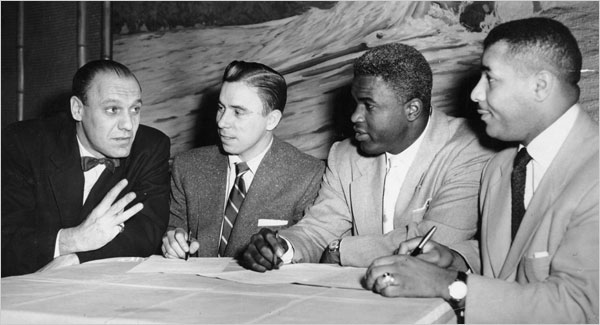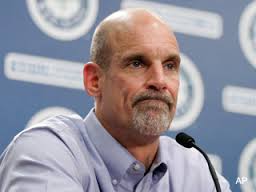As much as I have followed minor league baseball and paid attention to the art and science of scouting, especially by the Dodgers, I have never paid much attention to the Major League Scouting Bureau (MLSB). I knew it existed but really didn’t understand the mandate of the Bureau. When I learned that Bill Bavasi, son of longtime former Dodgers executive Buzzie Bavasi, had been recently named director of MLSB it caused me to do a bit of research and to correct an oversight on my part.
The Major League Scouting Bureau was formed in 1974 as team ownership developed the idea to centralize scouting with centralized scouting information prior to each amateur draft. Initially membership in the MLSB was optional when 17 of 24 teams joined the Bureau but became mandatory in 1984. At its inception it functioned as an independent group supported by the participating major league clubs. In 1985 Commissioner Peter Uebberoth brought the Major League Scouting Bureau under the umbrella of the Commissioner’s Office.
The Major League Scouting Bureau, with its headquarters in Ontario, California, continues to operate under the auspices of the Commissioner’s Office. It offers the same scouting information to all 30 major league teams and runs parallel to the scouting operations of those clubs supplementing their professional scouting operation. The Bureau employs a staff of more than 30 full time and 12 or more part time scouts assigned to areas in the United States, Canada and Puerto Rico.
The big push for the Bureau each year is to provide information on amateur prospects as part of its mission to support the efforts of MLB clubs in the annual First Year Player Draft. In addition to written and anecdotal reports the Bureau provides video footage of players throughout the amateur ranks, both domestically and internationally. It also maintains an eligibility file on amateur players — many of them teenagers.
The Major League Scouting Bureau also scouts every level of minor league baseball from full season A through AAA as well as the Arizona Fall League and a number of winter leagues. If a player from one of these circuits is released or being considered in a trade, information on that athlete is easily accessible for any club that may request it.
As it evolved, the Bureau has gone beyond simply following players already playing in organized high school and college leagues or at the minor league professional level. Each year a series of 35 or more Tryout Camps are now held following the June draft. Players 16 or older are invited to these camps to display their wares. In doing so, the Bureau is attempting to gain even greater coverage of aspiring players, especially those that might have somehow fallen through the cracks in their scouting system. The Tryout Camp closest to me is being held one hour away on Tuesday, July 1st at Beazley Field in Dartmouth, Novas Scotia in Canada. I expect Canada Day celebrations with my family will prevent me from sneaking a peak at that camp.
Beginning in 1989 the Major League Scouting Bureau expanded its mandate to include an annual Scout Development Program. That is, a Scout School held in Phoenix, AZ for prospective scouts with a 12-day course designed to teach the basics of baseball scouting. Prior to its inception there was no formal training for major league baseball scouts. The school is not mandatory but is available to aspiring scouts who have been sponsored by a major league team.
More than 1,200 prospective scouts have participated in the first 28 sessions of Scout School, and many of them have gone on to hold upper management positions with major league teams. Both general managers A.J. Preller of the Padres and Jeff Bridich of the Rockies are graduates of Scout School.
Jim Wilson who has a twelve year career in major league baseball, which included a no-hitter in 1954 when he defeated Philadelphia Phillies ace Robin Roberts 2-0, became the first head of the Scouting Bureau in 1974. He was subsequently unceremoniously fired by Commissioner Peter Ueberroth in 1985. Ueberroth came under fire for the decision as it was made without consultation with any members of the board of directors.
Don Pries, a 2012 recipient of the George Genovese Lifetime Achievement Award in Scouting served as the director of the MLSB from 1987 until 1998. During his time with the Bureau, along with the development of the scouting school, he helped design a computerized system that would help all 30 teams in major league baseball. He created another program for the Commissioner’s office that would help develop college students and enhance their skills. He remains a consultant to the MLSB.
In 1998 Frank Marcos took over as director of the MLSB after having worked with the Bureau for ten years. He began his scouting career in 1984, spending the season as part of the Dodgers’ scouting department. He moved over to the Angels that winter and scouted for that organization until he joined the Scouting Bureau in October 1988.
Marcos is credited with contributing to the further growth of the MLSB after the innovations completed by his predecessor Don Pries. Jonathan Mayo writes that there is no measuring his [Marcos] influence on the Scouting Bureau. His achievements include:
- 2000 – the Bureau began providing spring training and daily reports to general managers of every team
- MLSB began coverage of off-season leagues including the Arizona Fall League and a variety of winter leagues
- Significant improvements were achieved in the quality and the quantity of video
- The amount of video technicians went from two to five
- CLIPS service was created which allows uploading to clubs with state-of-the-art video
- Video has gone from roughly 300 players to over 4,000 players filmed
- Helped Major League Baseball’s efforts in Latin America in terms of organizing the amateur scene there
Marcos was very much on the cutting edge of the use in technology in scouting players and in communicating the results to all major league teams. However, he was not all about technology, and was very aware of observation and intuition regarding young players, as was former MLSB director Don Pries: “Scouting is an opinion,” Pries says, “Nobody is wrong. If it were an exact science, we wouldn’t be here. It’s a subjective business; have conviction in what you believe in.”
When asked about the difficulty of predicting who will make a good major league pitcher Frank Marcos responded: “You can always tell arm strength. We have radar guns for that, but you can’t put a radar gun on a player’s heart or head. If you had seen Todd Van Poppel, you would have been sure he was a can’t miss. But he did. And then sometimes you have overachievers. Orel Hershiser is a great example. Not too many people were high on him.”
Marcos continued: “The generic qualities that apply to both position players and pitchers are like aggressiveness, instinct, dedication and work ethic.”
Frank Marcos stepped down as the Director of the MLSB in November, 2014 after sixteen years in the position. Bill Bavasi – son of former Dodger general manager Buzzie Bavasi and the overseer of the first four World Series titles in franchise history – has stepped in to fill the void left by Marcos.

In his 18 years with the Dodgers (1951-1968), Buzzie Bavasi led the franchise to eight National League pennants and four World Series championships. Buzzie is seen here signing Dodger Hall of Famers Pee Wee Reese, Jackie Robinson and Roy Campanella prior to the 1953 season. (Photo credit – Patrick Burns)
Bavasi began his front office career in 1983 with the then California Angels where his father Buzzi was the Angels General Manager at the time. He spent 17 years with the Angels front office serving first as the Farm Director (1983-1990), then as the Director of Player Development (1991-1993) and finally sitting in the General Manager’s chair(1994-1999). Although he didn’t win a World Series with the Angels he did help set them up for their 2002 championship year by drafting players such as Troy Glaus, Darin Erstad, Jarrod Washburn, Scott Schoeneweis and Scot Shields.
Like his father, Bill Bavasi also has a Dodger connection having served as the Director of Player Development for the Dodgers in 2002 and 2003. During that time James Loney, Jonathan Broxton, Chad Billingsley and Matt Kemp were drafted by the Dodgers.
Following his two years with the Dodgers Bavasi was named General Manager of the Seattle Mariners in 2003. He did redevelop the Seattle farm system but his five year tenure with the Mariners was a shaky one. He seems he might have acquiesced to the temptation of a quick fix. That is, trading for veteran players at the expense of younger more promising players and signing veteran free agents several of whom had gone beyond their prime time years. He was relieved of his duties as General Manager in June of 2008.
One Bill Bavasi move Dodger fans will remember – with less than fondness – was his signing of Dodger free agent third baseman Adrian Beltre following the 2004 season in which Beltre had just celebrated a monster year with the Dodgers. On the season he hit 48 home runs and drove in 121 runs while finishing second in the National League Most Valuable Player balloting.
Following his dismissal by the Mariners in 2008, Bavasi joined the Cincinnati Reds front office serving as Vice President of Scouting, Player Development, and International Operations, a position he has held until the November announcement that he had become the Director of the Major League Scouting Bureau.
During his term in Cincinnati Bavasi and his drafting team selected, among others, pitcher Mike Leake, speedster Billy Hamilton and recent Dodger acquisition catcher Yasmani Grandal who was a first round draft selection in 2010, twelfth overall.
Former directors Don Pries and Frank Marcos have left Bill Bavasi a challenging path to follow. However, the whole world is his stage now. He inherits a vigorous domestic and international scouting system already in place waiting to be further refined and tailored to the needs of major league baseball and perhaps more importantly to the needs of the young men who are the sole object of the Major League Scouting Bureau.




 January 29th, 2015 at 6:00 am
January 29th, 2015 at 6:00 am  by Harold Uhlman
by Harold Uhlman 
 Posted in
Posted in 

Great article, Harold. I had no idea…ergo I learned a lot from this piece.
I’ve often wondered how (and why) teams shared scouting information. I never knew that it was actually required by MLB.
It’s great to see some Brooklyn Dodgers linage still in today’s game.
Each MLB team of course has their own scouting program which goes beyond the common body of scouting information provided by the MLSB. There are areas in Latin America where the Bureau has not yet ventured. I expect Bill Bavasi will work on that international expansion.